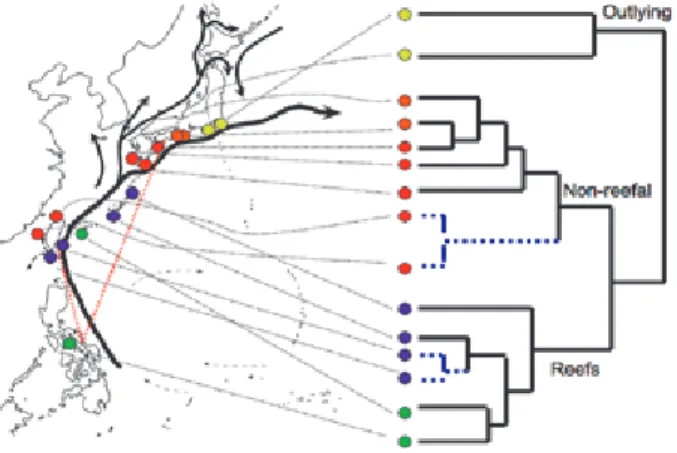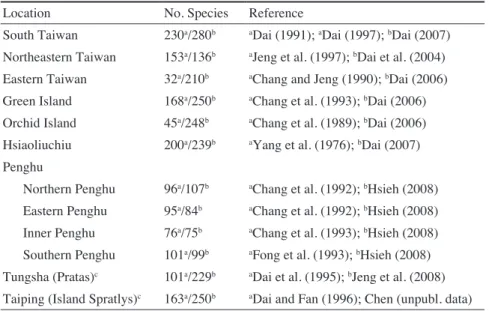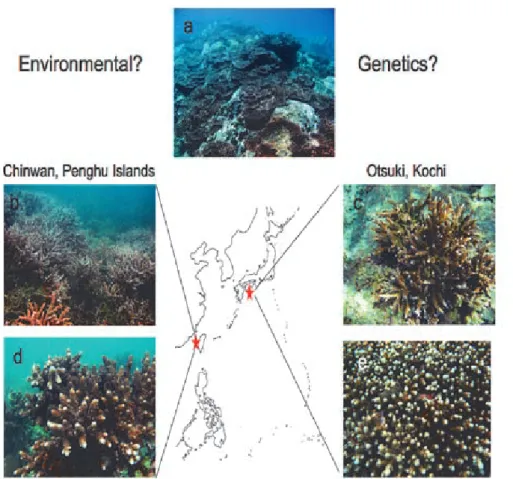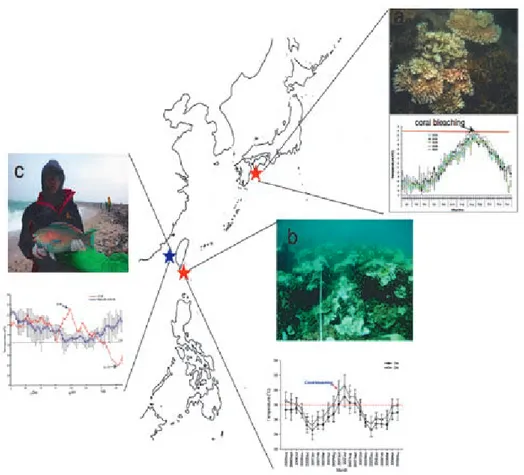*Corresponding author: e-mail cac@gate.sinica.edu.tw
Taiwan as a Connective Stepping-stone in the Kuroshio
Traiangle and the Conservation of Coral Ecosystems under the
Impacts of Climate Change
Chaolun Allen Chen* and Keshavmurthy Shashank
Coral Reef Evolutionary Ecology and Genetics Laboratory, Biodiversity Research Centre, Academia Sinica
(Nangang, Taipei 115, Taiwan)
Abstract
The Kuroshio Triangle, defined as the ocean area influenced by the strongest ocean current in the northwest Pacific, covers the coral ecosystems from the tropical Philippines, subtropical Taiwan and Okinawa, and the high latitudinal coral communities of Shikoku Island, Japan. Taiwan and its adjacent islands are situated in the midway corridor of the Kuroshio Triangle. In this paper the marine envi-ronment and scleractinian species diversity around Taiwan are reviewed, and their role in connecting upstream Philippine coral with downstream coral communities is examined along with the currently available literature. Community-based and population genetic analyses of scleractinians indicate that a distinct boundary of coral community shifting and genetic subdivision occurs around the seas of Taiwan. These results highlight the important role of Taiwanese corals in supporting not only the downstream coral reefs in Okinawa, but also those further up in the high latitudinal coral communities in Shikoku within the Kuroshio Triangle. Lastly, the knowledge gaps and potential research projects regarding the impact of climate change are highlighted to underscore the need for interdisciplinary and transboundary collaboration to elucidate connectivity issues and the future conservation of coral ecosystems in the Kuroshio Triangle.
Keywords: climate change, connectivity, conservation, Kuroshio Triangle, scleractinian coral commu-nity
Introduction
Latitudinal distribution of scleractinian corals is pre-sumably influenced by local physical environmental con-straints (Veron 2000). Three major regions of the Indo-Pacific area, namely Philippines-Japan, South Papua New Guinea-Eastern Australia, and Western Australia, have been the most comprehensively studied for their regional connections (Veron 1993 1995 2000). From these areas, extensive oceanographic data were obtained providing the chance to study relationships between distribu-tion patterns and physical-environmental factors in the Philippine-Japan island arc (Veron and Minchin 1992). The Kuroshio current (Fig. 1) originates in the northern Philippines, enters the East China Sea through a strait between Taiwan and the Yaeyama Islands, and flows northward to the west of the Ryukyu Islands (Veron and Minchin 1992, reviewed in Veron 1995). This current, in combination with the effect of sea surface temperature
limits, has divided scleractinian distribution along the Philippine-Japan Island arc into 3 groups: tropical reefs, temperate non-reefal communities, and high-latitude outlying populations (Veron 1992, Veron and Minchin 1992, Veron 1995 2000, Fig. 1).
Taiwan is the largest continental island located at the centre or junction of the Philippine-Japan island arc (Fig. 1). There are 85 islands or islets around Taiwan. To the east of Taiwan, the submarine topology drops steeply to 4000 m, and is close to the nearby Ryukyu Trench (Chu 1971). In contrast, the Taiwan Strait, situ-ated to the west between Taiwan and mainland China, is a shallow channel with sandy or muddy habitats. The Penghu Archipelago composed of 64 islets, also known as Pescadores (Islets of Fishermen in Portuguese), is located at the eastern side of the Taiwan Strait (Fig. 2).
The Occurrence of scleractinians is influenced by sea surface currents and sea surface temperature (SST) around Taiwan (Fig. 2). The strong Kuroshio Current
flows northward passing Orchid Island (Lanyu) and Green Island (Lutao); a branch of the Kuroshio flows to the Taiwan Strait up to Hsiaoliuchiu and southern Penghu in winter. This side-branch can penetrate across the Tropic of Cancer into more northern areas along the western shoreline during summer time (Fig. 2). The high SST of the Kuroshio current plays an important role in maintaining the average temperature of the
south-eastern Taiwanese coast and islands above 20 ℃ during winter. In summer, the South China Sea Surface Current (SCSSC) driven by the southwestern monsoon flows northwards into the Taiwan Strait through the Penghu channel, which may assist the flows of this Kuroshio branch to rejoin the main stream northwards. In contrast, the cold fresh China Coastal Water (CCW) driven by the northeast monsoon can enter the southern Taiwan Strait during winter (Jan 1995). The intrusion of the CCW can bring the SST below 18oC in the northern Penghu and northeastern coast of Taiwan in winter, thus confining reef development in these two regions. Nevertheless, the conjunction of different current systems and monsoons not only creates the unique distribution patterns of coral communities within a small geographical area (Chen 1999), but also provides important fishing grounds for local economic use.
1. Coral Reefs and Communities of Taiwan
Scleractinians have been reported from 7 major regions, including northeastern Taiwan, eastern Taiwan, southern Taiwan, the Penghu Islands, Hsiaoliuchiu, Green Island, and Orchid Island (Fig. 2, reviewed in Dai 1997, Chen 1999), as well as Tungsha Atoll (Pratas) and Taiping Island (Its Aba, Spratly) in the South China Sea. Except for Tungsha and Taiping Island, the other 7 regions are influenced by the Kuroshio current. So far, about 300 species of scleractinian corals have been recorded in Taiwan and the number of species is increasing following the investment of greater efforts in the last 5 years (Table 1). Scleractinian species diversity is relatively high in southern Taiwan (280), Hsiaoliuchu (239), Green Island (250), Orchid Island (248), Taiping Island (250), and Tungsha Atoll (229). Topologically, while Hsiaoliuchu and Taiping Island are coral islands, and Tungsha is an atoll, the other coral reefs around Taiwan are typical fringing reefs. Off the eastern coast of Taiwan, some fringing reefs have developed along the Taitung coast with over 210 scleractinian coral species recorded (Fig. 3, Dai 2006; Chen unpubl. Data). In con-trast, off the Penghu Islands and the northeastern coast of Taiwan, coral reef is unable to develop due to tempera-ture constraints (<18 ℃). Thus, the number of species is significantly lower in these two regions, even though the geographic distance from these two regions to the coral reefs is less than 200 km. Nevertheless, well-developed coral communities, sometimes mixed with algal reefs, are observed in these two regions (Fig. 3). Chen (1999) analysed the distributional patterns of coral reefs and coral communities recorded before 1997, indicating that Fig. 1 Main Kuroshio Current and its branches into
the South China Sea and the Taiwan Strait (black dot arrows), Kuroshio Triangle (red dotline), and the distribution of coral reefs, non-reefal coral communities, and outlying coral communities in the Kuroshio Triangle Distributional information was complied from Veron and Minchin (1993), Veron (2000), Chen (1999), and updated data reviewed in Table 1. Immerge of Taiwanese coral reefs and commu-nities (blue dotline) in the tree of Veron (2000) were based on (1) formation of reefs; and (2) the similarity of the number of species among the Japanese dataset (Veron and Minchin 1993) and those from the updated data listed in Table 1.
Fig. 2 Distribution of coral reefs and non-reefal com-munities and minimum winter temperature among the 7 published databases in Taiwan Data are modified from Chen (1999). Sea surface currents flowing through Taiwan and its adjacent islets are indicated by different arrow patterns.
Fig. 3 Example of scleractinian coral reefs and communities in major sites around Taiwan and its adjacent islets Table 1. Number of scleractinian species recorded from the coral reefs and
coral community around the Taiwanese legal districts
Location No. Species Reference
South Taiwan 230a/280b aDai (1991); aDai (1997); bDai (2007) Northeastern Taiwan 153a/136b aJeng et al. (1997); bDai et al. (2004) Eastern Taiwan 32a/210b aChang and Jeng (1990); bDai (2006) Green Island 168a/250b aChang et al. (1993); bDai (2006) Orchid Island 45a/248b aChang et al. (1989); bDai (2006) Hsiaoliuchiu 200a/239b aYang et al. (1976); bDai (2007) Penghu
Northern Penghu 96a/107b aChang et al. (1992); bHsieh (2008) Eastern Penghu 95a/84b aChang et al. (1992); bHsieh (2008) Inner Penghu 76a/75b aChang et al. (1993); bHsieh (2008) Southern Penghu 101a/99b aFong et al. (1993); bHsieh (2008) Tungsha (Pratas)c 101a/229b aDai et al. (1995); bJeng et al. (2008) Taiping (Island Spratlys)c 163a/250b aDai and Fan (1996); Chen (unpubl. data) asurvey data gathered from the 1970s to the 1990s.
bupdated data after 2000.
cboth Tungsha and Taiping Island are not included in the analyses in Fig. 1 and Fig. 2, since both regions are not directly affected by the Kuroshio current.
two distinct groups can be identified in congruence with the sea surface temperatures and current systems around Taiwan (Fig. 2). One group, including Kenting, Green Island, Orchid Island and Hsiaoliuchu, represent a typical coral reef system, which can be associated with counter-parts in the Philippine and Okinawan archipelagoes. The other group, in contrast contains all the regional species compositions (except the southern islands) in Penghu and the northeast coast of Taiwan, and is characterized by non-reefal coral communities, which more closely resemble regions in high latitudinal Japan (Fig. 1). This distinct pattern of scleractinian distribution around Taiwanese waters is more robust in the surveys con-ducted after 2000. Interestingly, distinct fauna composi-tions with spatial scales smaller than 450 km in distance were not confined to scleractinian corals but were also revealed in fish (Shao et al. 1997), and probably in other marine invertebrates and macro-algae (Chiu and Lin, per. comm.). With its high diversity of scleractinians, a unique distributional pattern, and its central geographic position along the Kuroshio region, it has been proposed that Taiwanese coral reefs and coral communities serve as a “stepping stone” for the northward and eastward dis-persal of shallow water reef organisms (Dai 1989 1991).
2. The Role of the Taiwanese Coral Ecosystems in the “Kuroshio Triangle”: the stepping stone hypothesis
The “Kuroshio Triangle” (KT), going from Bicol, in the Philippines, through Taitung, Taiwan, to Kochi, Shikoku, Japan (Fig. 1), is proposed to encompass the entire range of marine diversity, fishery economics, and cultural exchange influenced by the Kuroshio Current (Morooka 2008). As one of these three vertices, Taiwan undoubtedly plays an important role in connecting the upstream Philippines with downstream Shikoku, Japan (Fig. 1). First, three major patterns of coral species composition, tropical reef, non-reefal community, and outlying community, are defined (Veron 2000). Taiwan displays two distinct patterns corresponding with both Japan and the Philippines (Chen 1999). Second, even within similar latitudes around Taiwan, species diver-sity in some regions, such as the Penghu islands (Hsieh 2008) and the northeastern coast of Taiwan (Dai. 1997), is significantly lower than, but shares similar numbers of species with, the high latitudinal coral communi-ties in Japan, such as those recorded in Otsuki, Kochi
Prefecture (Nomura and Mezaki 2005). For example, the Penghu Islands and Otsuki are not only similar in term of the number of coral species, but also share a similar coral community structure dominated by monospecific coverage of Acropora muricata and A. hyacinthus (Fig. 4, Chen per. obser.). These lines of research imply either that Taiwan serves as a steppingstone connecting coral species in the Kuroshio Triangle, or that local environ-mental factors can influence the coral community struc-ture in both Penghu-northeast Taiwan and the Otsuki region of Shikoku (Fig. 4). However, more data are needed to confirm these scenarios.
3. Climate Change Issues concerning Coral Ecosystems in the Kuroshio Triangle
Despite the high marine species diversity, coral eco-systems in the Kuroshio Triangle are inevitably facing the same four threats that all the Pacific Islands do. These four threats are overfishing, pollution, habitat destruc-tion, and climate change. Amongst these four threats, cli-mate change accelerates the synergetic effect that could
worsen the situation arising from the other three effects (Hughes et al. 2003; Hoegh-Guldberg et al. 2007). The bleaching and subsequent death of reef-building corals caused by warm water pulses has destroyed reef ecosys-tems, which may require several decades to recover (Fig. 5a, b). Laboratory studies have shown that some ocean areas have already acidified due to CO2 acidosis, which is shifting the ecological balance of marine plankton, mollusc, and scleractinian corals that form calcium skel-etons. In addition, extreme weather patterns, such as unusual cold and fresh water intrusion (Fig. 5c), which creates collapses of coral reef fishery and local extinction of certain coral species, has already been observed in the Penghu Islands, Taiwan (Hsieh et al. 2008). The rates of current environmental change are likely to accelerate in the near future. As an expected consequence, these changes are going to increase the number of impov-erished people and reduce stability in the Kuroshio Triangle.
Fig. 5 Examples of coral stress episodes in the Kuroshio Triangle
Coral bleaching was recorded in (a) September, 2007 in Otsuki, Shikoku, and (b) July, 2007 in the Kenting Reefs Taiwan and in Japan. (c) Extremely low temperature was recorded in Penghu Islands between December, 2007 and January, 2008 (Hsieh et al. 2008).
4. Knowledge Gaps and Potential Research Directions
The “Kuroshio Triangle” (KT) stretches from the northeast Philippines, through Taiwan and Okinawa, to Shikoku, Japan, covering a latitude range of over 2000 km. This area is approximately equal to the size of the Great Barrier Reef (GBR) along the east coast of Australia. However, the topology, ocean currents, utilization of marine resources, and even the political boundaries are very different between these two coral ecosystems, suggesting that the evolutionary and ecolog-ical driving forces behind the KT and the GBR coral eco-systems might be quite different. For example, genetic data on several coral species indicates that there is little genetic diversity among different reefs and no distinct genetic break in the GBR (reviewed in Van Oppen and Gate 2006). Similar results are observed in the Okinawan reefs (Nishikawa and Sakai 2005). In contrast, significant genetic breaks between Penghu-northeast Taiwan and the Kenting reefs are observed in two foliose corals in Taiwan, although the distant between these three sites in Taiwan is less than 400 km (Yu et al. 1999; Dai et al. 2000). Thus, if the KT is considered as one ecosystem for future research purposes, particularly with regard to facing the impact of climate change in this region, several knowledge gaps should be filled:
a. What is the role of the Kuroshio Current in facili-tating the transportation of reef-associated organisms, including corals, fish, other invertebrates, and algae, from the downstream to the upstream KT?
b. What is the role of monsoon-driven current systems, such as the SCSSC, in interfering with this transport system of the KT?
c. Do the reef-associated organisms reflect similar bio-geographic patterns as shown in scleractinian corals? d. Will /have tropical corals migrate/migrated to the high
latitudinal KT in response to climate change? Is there any historical data from high latitude Japan to provide baseline data with which to infer this ecological phe-nomenon?
e. If so, what are the consequences of shifting species composition in the KT region over time? Are the high latitude coral communities in Japan the refugia for the future survival of scleractinian corals?
f. Will the new migrants out-compete the indigenous spe-cies in the high latitude KT causing local extinction of those species?, and
g. What will be the response of other species and whole communities?
In order to tackle these seven knowledge gapes,
an interdisciplinary, transboundary, and international effort should be undertaken among the researchers in the Philippines, Taiwan, and Japan. Seven potential research projects are proposed, including:
a. Genetic connectivity of marine organisms, influence of current systems, and the hypothesis of Taiwan as a steppingstone.
b. Examining physiological variation of corals and their associated microbes from different communities in response to extreme temperature and acidification in the KT.
c. Long term ecological study on the change of coral/ seagrass/ seaweed communities.
d. Endemism of corals and coral-associated organisms in the high latitudinal regions.
e. Experimental approaches to the study of the competi-tion between migrated and residential species.
f. Hybridisation and genetic contamination of migrants with the endemic species.
g. Socio-economic impacts and adaptive management for coral ecosystems in the Kuroshio Triangle.
Conclusion
The Kuroshio Triangle, defined as an ocean area influenced by the strongest ocean current in the north-west Pacific, covers the coral ecosystems from the tropical Philippines, subtropical Taiwan and Okinawa, and the high latitudinal coral community off Shikoku Island, Japan. Taiwan and its adjacent islands are situated midway in the corridor of the Kuroshio Triangle. The preliminary research based on community and genetic structure analyses of scleractinian corals indicates that Taiwan could play the role of a stepping stone to connect the upstream reefs with the downstream outlying coral communities. However, coral ecosystems in Taiwan as well as their counterparts in the Kuroshio Triangle, like most of the coral reefs of the Pacific, have already been degraded or are inevitably affected by the future threats of climate change. In several areas, knowledge gaps urgently need to be filled in order to overcome this trend. Research projects built on interdisciplinary and transboundary collaboration are important to clarify the future sustainability of coral ecosystems in the Kuroshio Triangle.
Acknowledgement
Many thanks to Prof. Yoshinori Morooka, Prof. Kazuo Okuda, and Prof. Hin-Ku Mok, for the invitation to attend the ‘’International Symposium for Kuroshio
Studies’’ held in National Sun Yat-sen University, December 2008. Keshavmurthy Shashank is supported by the National Science Council (NSC) Postdoc Fellowship (2008-2009). We thank Prof. Chang-Feng Dai and Ms Sharon Horn for the updated list of scleractinian corals in Table 1, Dr. Justin Hernyi Hsieh for sharing the unpub-lished data of scleractinian species in Penghu, Chao-yung Kuo for preparing Figure 1, and Mr. Fumihito Iwase and Biological Institute Kuroshio, Otsuki, Japan for their hospitality during our visit. The preparation of this manuscript was supported by research funding from the NSC, Academia Sinica Thematic Grant (2008-2010), and infrastructure grants of the Biodiversity Research Centre, Academia Sinica (BRCAS) to CAC. This is the Coral Reef Evolutionary Ecology and Genetics Group, BRCAS contribution No. 54.
References
Chang, K., Chang, S., Su, Y., Chang, C., Lin, Y., Liu, L. and Yang, P. 1989. Investigation and evalu-ation of natural resources of the Lanyu (Orchid Island) National Park. Bureau of Construction and Planning, Ministry of Interior.
Chang, K., Chiang, Y., Chen, C., Jan, R., Dai, C. and Jeng, M. 1992. Marine biological resources in the north sea of Penghu. Penghu Scenic Area Administration, Bureau of Tourism, Ministry of Communication.
Chang, K., Jan, R., Dai, C., Tseng, R., Jeng, M. and Su, Y. 1991. Investigation and conservation studies on marine biological resources of the Green Island. East Coast Scenic Area Administration, Bureau of Tourism, Ministry of Communication.
Chen, C. 1999. Analysis of scleractinian distribution in Taiwan indicating a pattern congruent with sea surface temperatures and currents: examples from
Acropora dn Faviidae. Zool. Stud.,38.
Chu, T. 1971. Environmental study of the surrounding waters of Taiwan.. Sino-American Science Cooperation Colloquium on Ocean Resources II. Dai, C. 1989. Scleractinia of Taiwan I. Families
Astrocoeniidae and Pocilloporidae. Acta Oceanogr. Taiwanica, 22, pp. 83-101.
Dai, C. 1991. Reef environment and coral fauna of southern Taiwan. Atoll Res. Bull., 354, pp. 1-28. Dai, C. 1997. Assessment of the present health of coral
reefs in Taiwan. In: Grigg R, Birkeland C. (eds) Status of coral reefs in the Pacific. Univ. of Hawaii, Honolulu, pp 123-131.
Dai, C. 2006. Distribution and species diversity of reef
corals in Taiwan (II), Technique report. Bureau of Fishery, Executive Yuan.
Dai, C. 2007. Distribution and species diversity of reef corals in Taiwan (III), Technique report. Bureau of Fishery, Executive Yuan.
Dai, C. and Fan, T. 1996. Coral founa of Taiping Island (Itu Aba) in the Spratlys of the South China Sea.
Atoll Res. Bull., 436, pp.1-21
Dai, C., Fan, T. and Wu, C. 1995. Coral Fauna of Tungsha Tao (Pratas Island). Acta Oceanogr.
Taiwanica, 34, pp.1-16.
Dai, C., Fan, T. and Yu, J. 2000. Reproductive isolation and genetic differentiationof a scleractinian coral Mycdeium elephantotus. Mar. Ecol. Prog. Ser., 201, pp. 179-187.
Dai, C., Soong, K., Jeng, M., Chen, C.and Fan, T. 2004. Current status of coral reefs in Taiwan. Council of Agriculture, Executive Yuan.
Fong, H., Mok, H., Chen, H., Soong, K. and Liu, L. 1993. Marine biological resources of the south sea of Penghu. Penghu Special Scenic Area Administration, Bureau of Tourism, Ministry of Communication.
Hoegh-Guldberg, O. P.J. M, AJ, H. et al. 2007. Coral reefs under rapid climate change and ocean acidi-fication. Science, 318:, pp. 1737-1742.
Hsieh, H. 2008. Coral community of Penghu Islands. PhD thesis, National Taiwan Univesity.
Hsieh, H., Hsien, Y., Tsai, W., Su, W., Jeng, M. and Chen, C. 2008. Tropical fishes killed by the cold. Coral Reefs,, 27, p. 599.
Hughes, T.P., Baird, A.H., Bellwood, D.R., Card, M., Connolly, S.R., Folke, C., Grosberg, R., Hoegh-Guldberg, O., Jackson, J.B.C., Kleypas, J., Lough, J.M., Marshall, P., Nystrom, M., Palumbi, S.R., Pandolfi, J.M., Rosen, B. and Roughgarden, J. 2003. Climate change, human impacts, and the resilience of coral reefs. Science, 301, pp. 929-933.
Jan, S. 1995. Current around Taiwan. PhD, thesis, National Taiwan University.
Jeng, M., Dai, C., Chen, C., Wang, W .and Meng, P. 2008. Biological diversity and environment of the Tungsha Marine National Park. Marine National Park, Construction and Planning Agency, Ministry of Interior, Taiwan, Kaoshiung.
Jeng, M., Jan, R., Tzeng, C. and Fang, F. 1997. Survey and monitoring of natural ecological resources in the Northeast Coast National Scenic Area (III). Northeast Coast National Scenic Area Administration, Bureau of Tourism, Ministry of
Communication.
Morooka, Y. 2008. Framework of the joint Kuroshio workshop, In Recent changes in the seaweed ecosystem along the Kuroshio Current, “Towards collaborative rehabilitation of the cradle of fishes” (Morooka,Y. and Okuda, K. (eds). Kuroshio
Science. 2-1, pp. 11-13.
Nishikawa, A. and Sakai, K. 2005. Genetic connec-tivity of the scleractinian coral Goniastrea aspera around the Okinawa Islands. Coral Reefs, 24, pp. 318-323.
Nomura, K. and Mezaki, T. 2005. Reef building corals from Otsuki, Kochi Prefecture, Japan. Kuroshio
Biosphere 2, pp. 29-41.
Shao, K., Chen, J. and Wang, S. 1997. Distribution and database of marine fishes in Taiwanese waters.
Proc. 7th Indo-Pacific Fish Conference.
Van Oppen, M. and Gates, R. 2006. Conservation genetics and the resilience of reef-building corals.
Mol. Ecol. 15, pp. 3863-3883.
Veron, J. 1992. Hermatypic corals of Japan. Aust. Inst.
Mar. Sci. Monogra. Series 8.
Veron, J. 1993. A biogeographic database of hermatypic
corals: species of the central Indo-Pacific, general of the World. Aust. Inst. Mar. Sci. Monogr. Series 9.
Veron, J. 1995. Coral in space and time. Univ. of New South Wale Press, Sydney.
Veron, J. 2000. Corals of the World. Australian Institute of Marine Sciences, Townsville.
Veron, J. and Minchin, P. 1992. Correlation between sea surface temperature, circulation patterns and the distribution of hermatypic corals of Japan.
Continetal Shelf Res.,12, pp. 835-857.
Yang, R., Huang, C., Wang, C., Yeh, S., Jan, Y., Liu, S., Chen, C., Chen, S., Chang, L., Sun, C., Huang, W. and Tsai, T. 1976. A marine biological data acquistion program in the Nawan Bay area. Phase I. A preliminary reconnaissance survey. Inst.
Oceanogr. Nat. Taiwan Univ. Spec. Publ. 11, pp.
1-133.
Yu, J., Wang, H., Lee, S. and Dai, C. 1999. Genetic structure of a scleractinian coral, Mycedinium
elephantotus, in Taiwan. Mar. Biol., 133,



